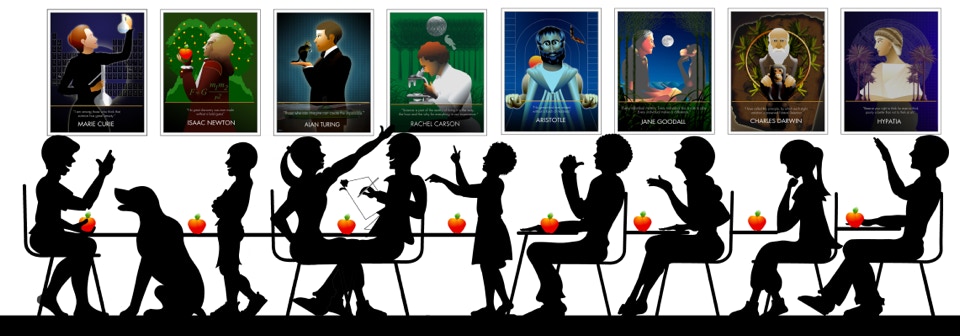May 16, 2022
Richard Nodine, art director, San Francisco CA 94102, website: pacprint.com.
WHY WE NEED GENUINE HEROES
“Too much sanity may be madness and the maddest of all,
to see life as it is and not as it should be.” ––Miguel de Cervantes
I had the good fortune to spend long periods of my career serving both the commercial and non-profit sectors of our economy. The commercial sector taught me the value of “image salesmanship” and the non-profits taught me the value of serving something greater than the bottom line.
In a conversation with a producer of educational films my client bemoaned a curious truth. “It’s becoming progressively more difficult to engage young people in the pursuit of academic excellence. There is too much distraction and scholastic achievement has become un-cool.” At first I was shocked, but then I recalled a TV interview in which a member of congress referred to President Obama as, “professorial,” as though that were the gravest insult he could muster.
My own education was unexceptional. My early years were spent in public schools where I was an average student. Yet we clearly understood that individuals who devote their careers to the proliferation of knowledge are to be held in high esteem. In the lexicon of my consciousness “professorial” was a compliment. Has our society’s perception undergone a seismic shift or has our education system failed to maintain standards that justify the respect of the populous?
The answer is probably, a little of both. The pragmatism of the digital era and the standardized test has rung much of the poetry from our schools. They now appear to promote advanced coding skills above all else. Moreover, young men (attracted to competition) find their prospects more firmly grounded in professional sports than philosophical debate. Every media (especially youth-oriented games) appears to exalt violent conflict at the expense of reasoned negotiation. Even our politics, presumably the bellwether of social norms, seems adversarial at best.
When we are prepared to reject the failed solutions of the past and to see life as it should be and not as it is we will discover the true heroes among us, those who have extracted elegant solutions from their intellect and dedication, not the suffering of others.
Your views on this issue would be greatly appreciated.
August 26, 2021
Richard Nodine, art director, San Francisco CA 94102, website: pacprint.com.
DEFENDING DIGITAL PRINTMAKING
I’ll begin by confessing my personal bias on this issue because I believe it to be well founded. The more time I spend with digital media the more I’ve learned to admire it as a true artistic medium, as valid as oil painting, water colors, sculpture or traditional printmaking. Unfortunately, a small minority still rejects this assertion, seemingly based on their Dickinson vision of an artist, locked away in their frigid garret, up to their elbows in ink and near starvation.
If you are among those who find this image romantic, I’m compelled to point out that, like everything, art and the methods by which it is expressed has evolved. One can offer a multitude of examples to refute the notion that art is detached from technology. However, I can easily argue that the rise of Impressionism and its offspring, Abstract Expressionism, were directly related to the advent and development of photography. Merely count the hoards of portrait and landscape artists who were liberated from the doldrums of their reportage-like careers and thus discovered new heights of self-expression. Did you know that Picasso’s Blue Period was probably less likely the product of psychic depression than the introduction of Windsor & Newton’s new and vastly less expensive blue pigments?
Not only does technology constantly amend our means of art production, it impacts the social-psychic impulses that underlie our inclinations to produce art. The horrors of war expressed by artists as diverse as Uccello, Turner, Goya, Picasso and Martha Rosler are, in fact, reactions to the progress society has achieved in the technology of destruction.
The clinching argument is that digital technology allows us to produce and reproduce original art on a level that was hitherto unachievable. Like woodcuts and engravings, the digital print can achieve effects that other mediums cannot. Thus, artists choose digital for the same reasons they would choose a linoleum block over a screen print. Digital media not only allows artists to shape, color and distort their own images, it gives them the freedom to incorporate historic references in much the same way a DJ samples preexisting sounds.
So why is it fair to financially degrade one artist’s work because he chooses PhotoShop brushes over horsehair? One might say that the digital printmaker is not subject to the same quantity restraints the engraver or lithographer encounters when they destroy their plates. Of course that would expose one’s naiveté concerning the number of “artist’s proofs” produced in most runs of analogue prints. In truth, any artist or publisher’s print count is only as good as the number of extra prints that surface months or years after an edition has ended.
A more realistic discrimination might involve the question, “Is this a print created by a technician who simply photographed an analogue work of art or was it substantially created by an artist through digital manipulation.” The former usually involves a financial decision while the latter involves many esthetic decisions.
Your views on this issue would be greatly appreciated.
Our blog is a moderated discussion of the role of art used to enrich and expand the educational experience. Even if you disagree we’re always interested in your perspectives, suggestions and criticisms. Simply describe your point of view in an
You may reference the current theme or begin a new thread. We reserve the right to decide whether or not to publish your submissions in our blog. As always, opinions supported by the author’s identifying data carry greater weight. We will make every attempt to acknowledge and respond to your submissions.

